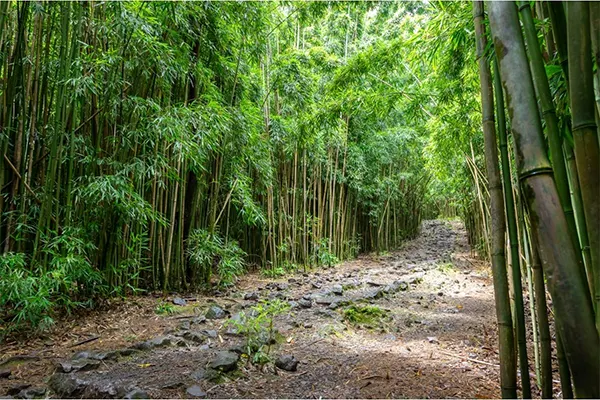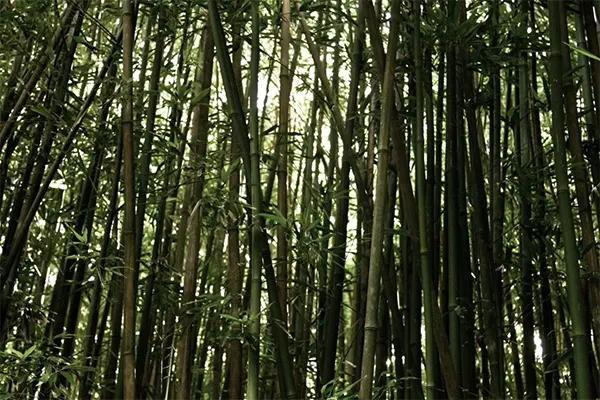The Bamboo forest is a hike that’s on many Maui visitors’ bucket lists because it’s just so engaging.
With long stalks of bamboo densely planted to form an enclosed trail, it feels like a step into another world.
Located at the end of the Road to Hana and as part of the Pipiwai trail, the bamboo forest is a difficult climb with some rewarding sights.
Find out more about the Maui bamboo forest hike with this guide.

It’s Not Just About The Bamboo
Table of Contents
It’s not that the bamboo alone isn’t worth seeing, but there are so many things to see on the Road to Hana that you have to be careful with your time.
But the bamboo hike is part of the Pipiwai Trail, which twists and turns through Haleakala National Park, passing by streams and waterfalls.
One of these is the exceptional Waimoku Falls, which stands 400-feet high with a rich cascade of water. There’s also the 200-foot Makahiku Falls, topped by an impressive natural infinity pool (which is not for swimming).
It Engages The Senses
Of course, the bamboo forest is incredible to see, but it can also be exciting to hear. On a windy day, the swaying stalks of the bamboo bump into each other, creating a magical atmosphere and a musical backdrop to your hike.
They mimic the sounds of a wind chime. The thick canopy of the bamboo also blocks out the sunshine, cooling the shaded area.
You Have To Look Up
The swaying bamboo towers above the trail and bends over, forming a dense canopy that restricts the strong Maui sunlight.
Traveling along the path, you have to be sure to look up to catch the mesmerizing sight of the bamboo swaying with the breeze.
Bring Waterproof Shoes With Closed Toes
As you hike the path to and from the bamboo forest, you’re going to pass by streams that need crossing. If you’re lucky, the water will be low, and you can keep your feet dry.
But this isn’t always the case. Some days, you will be expected to wade through the waters to carry on with the trail.
But don’t think a pair of sandals or flip-flops will do the job. The trail isn’t the most difficult one on Maui, but it can still be hard going.
And while sandals might protect your socks from the water, they leave your toes vulnerable to something rather more unpleasant: stinging centipedes.
These are big, and while the sting isn’t particularly dangerous, it’s still painful. And even if they don’t bite, the memory of a large centipede crawling over your toes is something you’ll never forget.
Stock Up On Snacks And Water
The bamboo hike is at the far end of the Road to Hana, in an area of Maui that’s largely wild and lacks the infrastructure of West and South Maui.
You should stock up on snacks and drinks further up the highway, as you won’t find facilities around the trail itself. The trail can get humid, and visitors can lose more water than they realize.
You Have To Pay To Get In
The bamboo hike is part of the Haleakala National Park. To park, you need to pay $30, but this gets you a three-day entrance ticket, which can also be used to visit Haleakala summit.
As part of Haleakala National Park, there are opening and closing times. The park opens at 9 am and closes at 5 pm.
You must be out before the park closes, or you will find yourself locked in! If you plan on doing the full hike, don’t start any later than 2 pm.
The Entire Trail Can Take Upwards Of Four Hours
The Pipiwai trail is a 4-mile round trip, although many walkers decide not to tackle the total route. It can take up to 4 hours, especially if you get caught up in admiring the view, or nailing the perfect bamboo selfie.
While the bamboo hike itself is level and easy to walk, the trail to the bamboo can get difficult in places. You might find it slow-going at times.
The bamboo forest takes roughly 20 minutes to walk. A hike to and from the bamboo forest can take around one hour.

Parts Of The Hike Are Very Difficult
The wonder of the Road to Hana is the untamed Maui landscape, and the Pipiwai trail gives visitors a chance to explore that landscape.
But the trail is only a small path, and the Maui wilderness is still a force. Paths can be tricky to cross, waterlogged, or gone altogether.
Heavy rainfall can lead to flash floods, and even during calm weather, debris still poses a risk around the waterfalls. If you plan on doing the full hike, then you have to be prepared for difficulties passing through.
It Isn’t Always Open
To protect the safety of visitors, the Pipiwai trail is sometimes closed to the public. Large amounts of footfall have caused several sections of the hike to become degraded and dangerous.
Fatalities have been recorded around the waterfalls, despite warning signs.
Increased visitor numbers have also damaged flora and fauna in the area. If you’re planning a day at the Pipiwai trail, check in advance to find out if it’s open.
There Are Other (Smaller) Bamboo Trails To Visit
Bamboo forests aren’t exactly a common sight on Maui, but the hike at Pipiwai isn’t the only place they can be seen.
On the Makamaka’ole Falls Trail, otherwise known as the 13 Crossings Trail, there’s a small section of bamboo forest. The walk is small, the bamboo is still huge.
Maui’s other famous bamboo hike is Na’ili’ili Haele, but this is not open for visitors. This is a very dangerous area and a common spot for serious injuries. It’s also on private property, and access will be prevented.
Final Thoughts
The bamboo forest is an unusual and mesmerizing sight on a trail that’s already packed with things to see.
Make sure to pack correctly, wear appropriate footwear, and pay attention to any warning signs. You’ll be rewarded with an engaging walk in a magical area.
